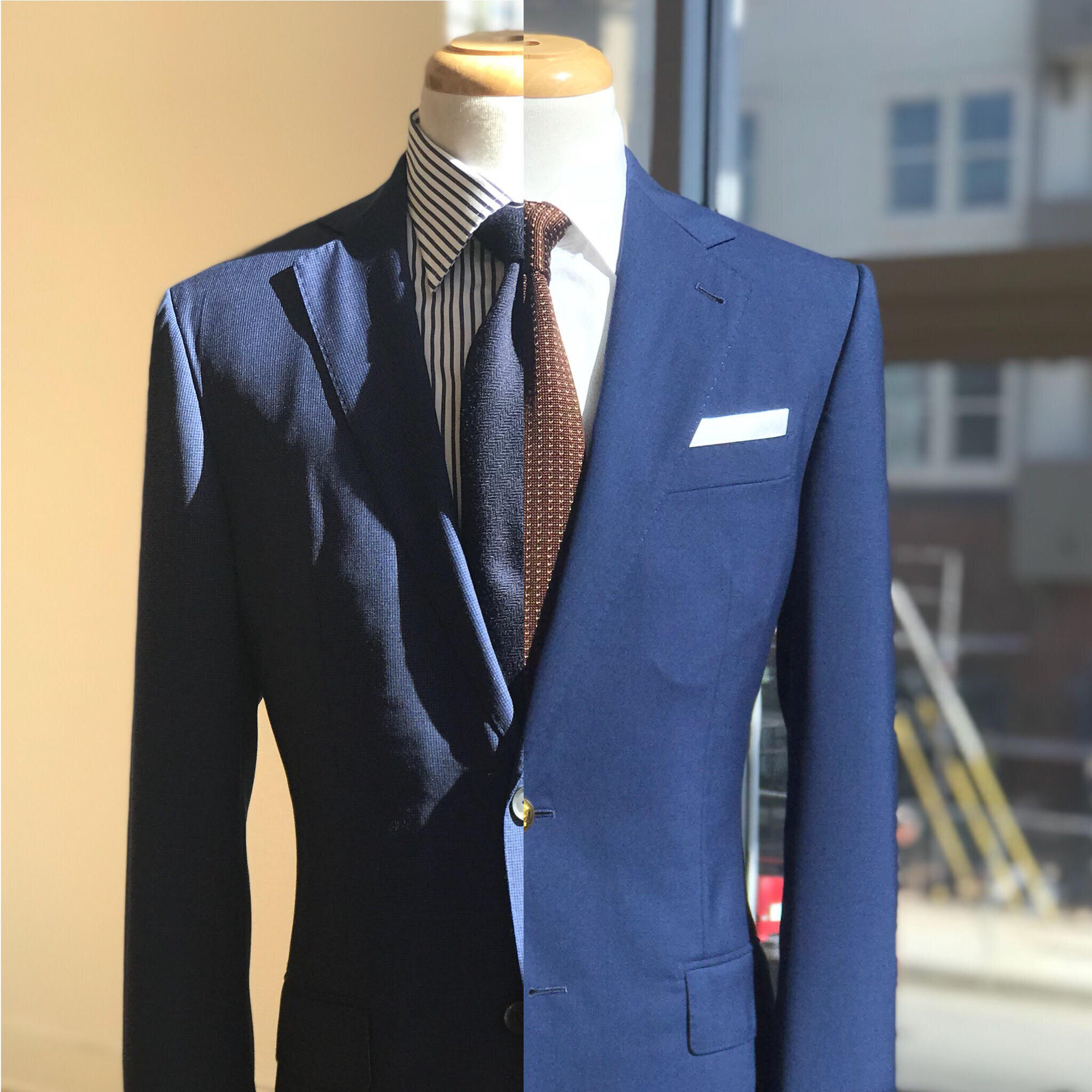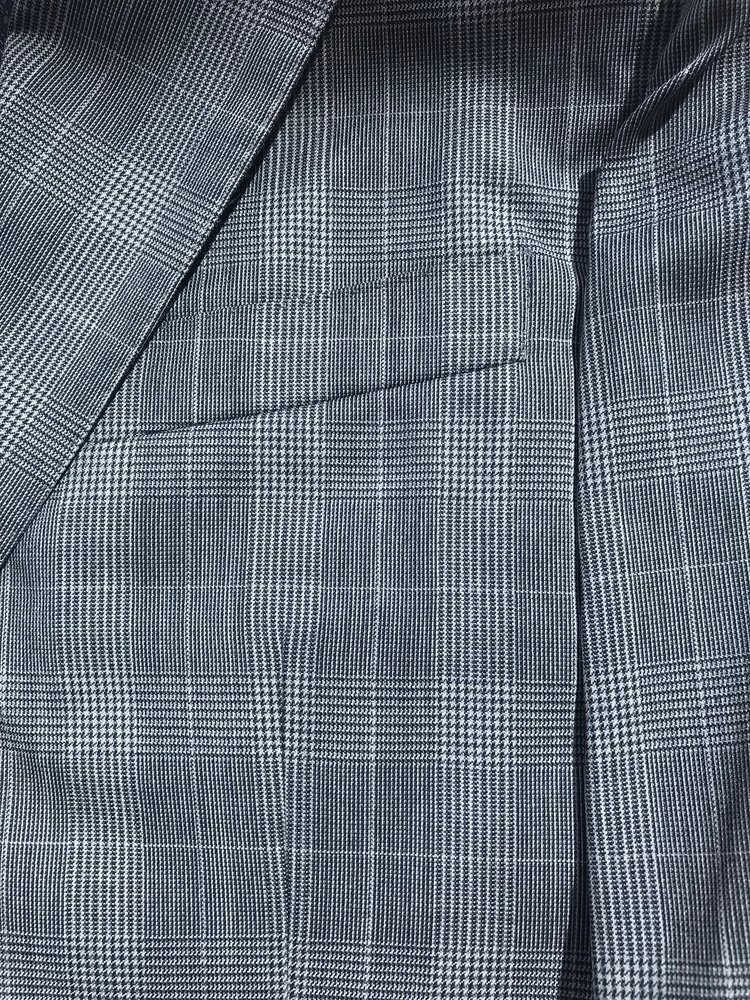Top 7 Traits of the Best Suits: Cheap Suits vs. The Best Suits
Got questions? Find answers here FAQ
Cheap Suits vs. The Best Suits — The Real Difference is Craftsmanship
When it comes to suits, price tags can be deceiving. What truly separates a cheap suit from a masterfully crafted bespoke garment is not the logo on the label — it’s the craftsmanship.
A well-made suit is a feat of engineering disguised as elegance. Every millimeter, every stitch tension, and every internal layer contributes to how the garment fits, drapes, and performs.
Here’s a detailed look at the technical traits that define the best suits — and how to identify them.
The Best Suits Are Hand-Made — Precision You Can Feel
Hand stitching the Arm Eye of the suit jacket creates flex. it allows the sleeve to move with the wearer
Hand-making a suit isn’t a romantic idea; it’s a technical advantage.
A hand-stitched garment allows the tailor to adjust thread tension, shape the fabric three-dimensionally, and control grain alignment — something no automated machine can replicate.
Each section (lapel roll, chest canvas, sleeve head, collar stand) is shaped by hand padding — a meticulous process where the tailor uses a needle to build subtle curves into flat cloth. These micro-stitches create elasticity and structure simultaneously, allowing the jacket to flex naturally with your body.
Machine-made suits, in contrast, are locked into flatness. The seams are tight and inflexible because the machine maintains uniform tension regardless of fabric density. This rigidity causes puckering at stress points and prevents the suit from adapting to the wearer’s movement.
Handmade = Human calibration.
The fabric breathes, the stitches move, and the result is a jacket that feels alive on your body.
A deconstructed Italian shoulder vs a British roped shoulder. A well made suti features a clean, crisp, straight shoulder line regardless of the shoulder style.
2. The Best Suits Have Clean, Straight Shoulders — The Architecture of Fit
The shoulder is the foundation of a tailored jacket — the most difficult area to construct and the easiest place to spot poor workmanship.
A high-quality suit exhibits a clean, uninterrupted shoulder line that follows the wearer’s natural slope. The sleeve head (where the sleeve joins the armhole) should drape cleanly with no divots or ripples.
In bespoke tailoring, the shoulder expression is engineered using precise pitch (the forward rotation of the sleeve relative to the torso), balanced padding, and controlled fullness in the sleeve crown.
Cheap suits rely on prefabricated shoulder pads and glued wadding. The lack of structural canvas means the sleeve is attached to a stiff, unresponsive base — causing dimples or ripples at the sleevehead.
A clean shoulder line, regardless of style — roped, natural, or unstructured — signals meticulous pattern engineering and balance.
Think of the shoulder as the chassis of a car — if it’s misaligned, everything else drives off course.
3. The Best Suits Use Canvas Construction — The Hidden Skeleton
The Chest canvas of a well made suit. Hand basted and cut to match the suits silhouette.
Inside every great suit is a hidden structure known as the canvas — a floating layer of horsehair, wool, and linen that gives the jacket its shape and soul.
In a full-canvas construction, the canvas extends from the shoulder seam down to the hem. It’s hand-stitched (not glued) to the outer fabric using a pad stitch — thousands of small, angled stitches that allow movement while maintaining form.
This technique gives the suit a natural roll through the chest and lapel, creating dimensional depth and fluidity. As the wearer moves, the canvas gently flexes, helping the garment “learn” their posture over time.
By contrast, fused suits use a thin synthetic layer glued between the fabric and lining. While faster and cheaper to produce, the adhesive stiffens the cloth, restricts airflow, and eventually bubbles or delaminates.
High-end suits may also feature half-canvas construction, a compromise that maintains shape in the chest and lapel while using light fusing below the waist for comfort.
Canvas = Anatomy. It’s what transforms fabric into form.
4. The Best Suits Have Patterns That Line Up — The Mark of Discipline
When you see a perfectly aligned plaid or stripe across a suit’s pockets, lapels, and side seams — that’s not luck. That’s discipline.
Pattern matching requires the cutter to calculate seam allowances, grain direction, and alignment points before a single piece is sewn. On checks or windowpanes, every millimeter counts.
Misaligned patterns create visual noise and break the symmetry of the suit’s architecture. On the other hand, precise alignment demonstrates control, planning, and respect for the cloth.
It’s one of those invisible luxuries that only other tailors and true connoisseurs notice — but it’s what separates “made to sell” from “made to last.”
The best pin stripe suits feature stripes that line up. Note how the stripes line up at the pockets and seams
The best check suits feature patterns that line up. Note how the checks line up at the pockets, sleeves and seams
Visible Hand pick stitches is a mark of quality in the best suits.
5. The Best Suits Feature Handcrafted Details — Function Meets Artistry
The details in a bespoke suit aren’t decorative; they’re functional enhancements refined over centuries.
Pick stitching: Subtle hand stitches along the lapel edges and pockets allow micro-flexibility where the fabric layers meet.
Button shanks: Hand-wrapped thread columns behind each button that prevent strain and let them move naturally.
Functional surgeon cuffs: Working sleeve buttons, a hallmark of genuine tailoring tradition.
Hand-set collars and lapels: Allows a soft, natural roll that machines can’t replicate.
These finishing touches require hours of additional work. They might seem minor, but together they give a suit its organic feel — movement without resistance, elegance without stiffness.
The best suits are built, not assembled.
Vitale Barberis is one of the top mills on Italy. Its a Hallmark of the best suits.
6.The Best Suits Are Made from Quality Fabrics — Engineering at the Fiber Level
The quality of a suit’s fabric determines not just its appearance, but its performance, drape, and resilience.
Fine suiting fabrics are woven from long-staple fibers with consistent tension, typically Super 100s–160s wool, worsted flannel, or high-twist merino. These offer strength, wrinkle resistance, and breathability.
A great fabric has dimensional stability — it maintains shape through wear, steam, and dry cleaning without excessive relaxation or shrinkage.
Two-ply yarn construction (two threads twisted together) provides a denser weave and better recovery. Lower-end suits use single-ply or synthetic blends, which flatten under stress and lose structure.
High-quality cloth also has a natural luster, known as the “hand,” and depth of color that results from proper finishing and milling — not artificial coatings.
It doesn’t matter if the mill is in Italy’s Biella, England’s Huddersfield, or Japan’s Ichinomiya — what matters is fiber integrity and loom precision.
Fabric is the foundation. Canvas gives form. Tailoring gives life.
7. The Best Suits Have a Point of View — Design with Intention
Every great suit expresses a philosophy.
The British Cut is structured, with roped shoulders and a defined waist suppression — ideal for formal authority.
The Italian Cut favors lightness, a soft shoulder, and a high armhole (scye) for freedom and sprezzatura.
The American Sack Suit offers a relaxed drape with minimal shaping — democratic and understated.
Each cut demands unique pattern engineering, balance, and canvas shaping. Cheap suits simplify these distinctions, producing generic silhouettes that fit everyone — and flatter no one.
A true bespoke suit has a point of view — it reflects your personality, your posture, and your purpose.
That’s the essence of sartorial intelligence: form designed around you.
The Bottom Line: Craftsmanship is the True Luxury
Luxury isn’t a logo — it’s time, precision, and mastery.
From hand-padded lapels to clean shoulders and natural drape, every element of a great suit is the result of thoughtful human skill. You can’t fake that level of quality — and you can’t rush it.
At Cutting Room Bespoke, we build garments to your architecture — designed around your proportions, lifestyle, and expression.
Because when craftsmanship meets intention, the result isn’t just a suit









